Tag: Dungeons and Dragons »
Idle Champions review
Planescape: Torment review
Loot & Legends Review
Knights of Pen & Paper is Free for a Limited Time - Don't Wait for a Natural 20, Get it Now!
Knights of Pen & Paper is a weird and wonderful "make your own" sort of RPG adventure that's as fun as it is funny. And right now it's free!
For a limited time - specifically from today through 11:59pm PDT next Monday - you can grab Behold Studios' fan letter to table top RPGs for nothing. Seeing as it's a pretty great game, I'd suggest doing just that.
This Week at 148Apps: November 18-22, 2013
Apps Are Us
How do you know what apps are worth your time and money? Just look to the review team at 148Apps. We sort through the chaos and find the apps you're looking for. The ones we love become Editor’s Choice, standing out above the many good apps and games with something just a little bit more to offer. Take a look at what we've been up to this week, and find even more in our Reviews Archive.
Clumsy Ninja

Clumsy Ninja is a casual “Tamagotchi-style” game starring an inept ninja and a humorous physics engine. The game has players train their ninja with the hope that, one day, they will no longer be clumsy. Between the rather impressive physics, fun challenges, and relatively innocuous free-to-play design, Clumsy Ninja is actually a pretty fun game. To play Clumsy Ninja, players can touch the environment or their ninja to interact with it. There are also a couple of menus that allow players to take on challenges for experience points and add new items to their training grounds. Almost everything a player does yields experience points, but the fastest way to move up the ninja ranks is to complete challenges – which can vary anywhere from punching bag training sessions to flinging the ninja on top of a roof. --Campbell Bird
Touchgrind Skate 2
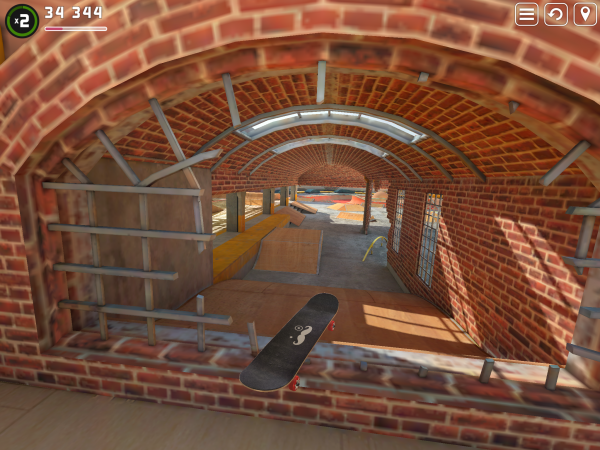
The original Touchgrind was one of the first games on the App Store that truly used multitouch controls to their potentital. Since then, so many games have continued to just use virtual controls, not truly taking advantage of their platform. However, Illusion Labs is back to show these sucka MCs just what’s up with the wonderful Touchgrind Skate 2. The game has been reborn in 2013 as something more like the Tony Hawk Pro Skater games in that players skate around a various skatepark-y environments chaining together tricks like spins, flips, and edge grinds. There’s a lengthy tutorial that has players seeing how to pull off the various maneuvers, with the ability to go back and re-watch and try individual sections in case more practice is necessary. Once in the actual game players can play a 100 second mode where they try to get the most points in that time limit, or a best line mode where a chain of tricks in a short time period can be attempted with the goal being to get the highest-scoring line. This mode is endless, with players able to keep playing until they get a score they’re satisfied with. --Carter Dotson
Lords of Waterdeep

Lords of Waterdeep is a Dungeons & Dragons-themed board game that has found its way onto iOS. Unlike other D&D adventures, players do not create characters and live out their fantasy lives in the land of Forgotten Realms. Instead, players take control of one of the masked lords of Waterdeep and manipulate warriors, rogues, and wizards to do their bidding for them. The result is an extremely well-designed, well-executed, and awesomely-themed worker placement game for 2 to 5 players. For the uninitiated, a worker placement board game is one in which the main action involves placing tokens – representing workers – on strategic locations on the game board. Placing a worker yields some sort of material gain, while (typically) also preventing opponents from accessing the same resources. In Lords of Waterdeep, the primary resources are money and adventurers (priest, warrior, rogue, and wizard); and these resources are gathered in order to complete quests. Upon completing quests players receive victory points, and the player with the most victory points at the end of eight rounds is declared the winner. --Campbell Bird
Oceanhorn
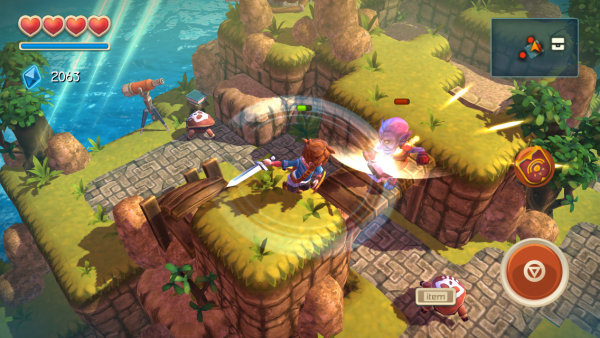
Oceanhorn, the Zelda-style action-RPG from Cornfox & Bros., has been anticipated for a while; but I came upon a game that falls short of the hype and its inspirations. Now, a high-quality 3D Zelda-style game just hasn’t been attempted much on mobile. And getting Nobuo Uematsu, composer for many of the Final Fantasy games to do the music? Unheard of! This is a game with a heady pedigree, and the ambition is rather apparent: it’s a beautiful-looking game. Play this on a retina iPad if possible: it chugged a bit on the new Retina Mini at times, but it looks absolutely immaculate. Whether it be in a dark dungeon, in a sunny town, or sailing on the high seas, this is a visual feast. And the orchestral soundtrack sets an appropriately epic mood. On the surface,Oceanhorn lives up to the hype. --Carter Dotson
A Charlie Brown Thanksgiving

Arriving at the perfect time in the Holiday Season, A Charlie Brown Thanksgiving is an utterly beguiling book app. It tells the classic tale of the same name, following Charlie Brown and the rest of the Peanuts gang as they discover the meaning of Thanksgiving. It’s easily a great read to share with the rest of the family. The app is laid out in a very family friendly format. An easy to understand tutorial ensures that young and old will know how to navigate through the app, mostly through a matter of swiping to the side. Occasionally, A Charlie Brown Thanksgiving reacts a little strangely, potentially down to the increasingly dated iPad 2′s loading times, but it’s mostly a smooth process. --Jennifer Allen
BeBop Blox
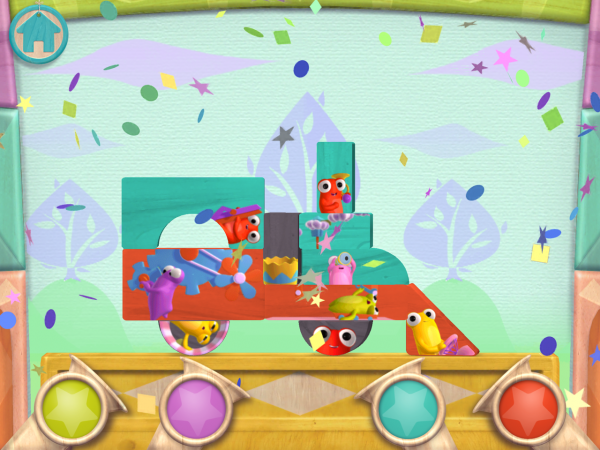
BeBop Blox is a cute and charming puzzle app for toddlers that adults will enjoy as well. BeBop Blox is a brightly-colored and musical puzzle app with Tangram elements that young children – through the use of stacking blocks – can use to create playful shapes including a train, boat, camel, or whale as well as other fun animal shapes. Gameplay is simple as children are guided in their building with the use of block templates which one fills. I admire that, although there is a moment where the more complex design can be seen. Building begins from the bottom up, allowing children to slowly add pieces – exercises that later may help them construct their favorite designs with their own building blocks. --Amy Solomon
Other 148Apps Network Sites
If you are looking for the best reviews of Android apps, just head right over to AndroidRundown. Here are just some of the reviews served up this week:
AndroidRundown
Random Heroes

May 2D platformers never die. Long live Random Heroes. As far as platforms go, this one has the basics down: adjusted left to right running, with baddies and leveled platforms to get to. Our hero is outfitted with a gun, but the gun does not perpetually shoot; the a button nestled to the right only shoots when pressed. Just to the left of this button is the jump button, and the bottom left of the screen has two directional buttons. --Tre Lawrence
Zombitsu

In Zombitsu, we get a running game, a ninja sword and zombies. Our ninja (Hiro) is outfitted with a sword to begin, and runs slicing up undead villagers and avoiding hazards that creep up along the way to stop progress. The view is an abbreviated top-down and behind angle, and this is affected by some game actions for brief moments. The zombies are all over, roaming on the sides of the running area and even directly in front. The base zombies are remarkably spry; there was a time or two I thought one was out of range only to have it knock me down behind some serious closing speed. --Tre Lawrence
Kunundrum
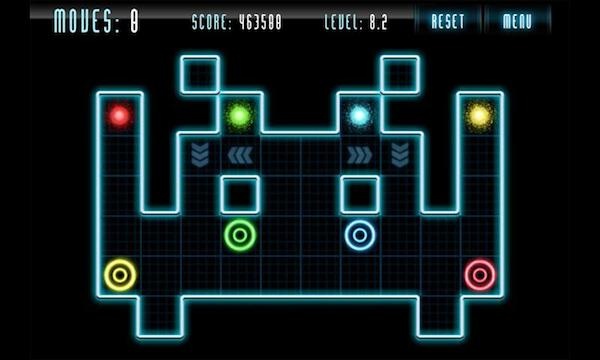
Kunundrum is a fancy puzzle game with neon graphics. Its gameplay reminds of classic Sokoban, but the rules are different. To be fair, there’s no way to describe them, without sounding like an accountant on his weekly report, so bear with me. The players are tasked to deliver several differently-colored shiny dots to their respective slots. The dots can be swiped across the field vertically and horizontally, and only stop when they hit a wall. If a dot is launched over its slot, it will skip over it, unless there’s a wall, or some other object in the way. Thus, the player needs to arrange the dots in such a way, that they would stop exactly over their slot. The fields are greatly different and contain lots of unique tiles. Some of these tiles change the direction that the orb is going, others act as switches for collapsible walls, and others teleport the sphere to another part of the level. The levels are numerous, so there are plenty of easy, mediocre and completely insane difficulties available. Three stars are awarded if the player manages to complete the level with the least possible number of moves. --Tony Kuzmin
And finally, this week Pocket Gamer went hands-on with the first official licensed iOS controller, reviewed Touchgrind Skate 2 and Shivah, highlighted the 17 best iOS and 10 best Android games of the week, picked out the hardest games on mobile, and helped you avoid scam apps on Google Play. All that and more, here.
iD&D: Dice Rollers Part 1
Welcome, readers, to another edition of iD&D. Last month we took an epic journey through the inner workings of the app store map power house, Battle Map. Our review took readers through the powerful tools that Battle Map offers, and showed the versatility of customization and real time interaction through the external monitor options. Check out the newest update for Battle Map in the app store now.
This month, we’re taking a dip into the wide world of dice rollers. They come in all shapes and sizes, from bare bones options to the extremely customizable and programmable options. There are tons of dice rollers out there, so we’ve decided to take a closer look at 3 different apps this month, three different apps next month, and provide a comparative analysis of each of these 6 apps. Well, I’m “die”ing to get into this month’s article so let’s jump right in.
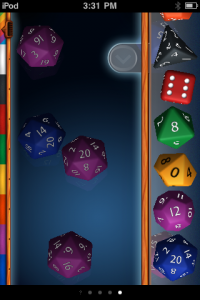
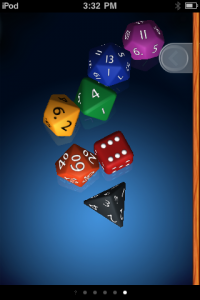
Pip uses an actual table that is rolled by shaking the iPod or iPhone. The physics engine powering Pip does a great job of emulating the actual movement that dice would make if shaken in a specific way. Pip offers multiple tables as well. These tables can be scrolled through with a swipe of the finger, offering some versatility in its simplicity.
Who Pip is for: Pip shines at the basic users must have dice roller. Its basic design and intuitive control structure make it an absolute asset in games.
Who Pip is not for: Pip isn’t for a complex player looking to calculate complex equations in a single roll. There is no “d20-4” options, so you’ll be doing your own math if you use Pip.
Issues: Pip’s drag and drop display is somewhat cut off on my 3rd gen iPod, making it difficult (but not impossible) to drag the percentile from the menu to the table.
Recommendation: If you’re looking for a simplistic dice roller, you cannot find a better option than Pip.
Side Note: In case you were not aware, a pip is the dot usually found on 6 sided dice that come with games such as monopoly. True to its name, Pip (the app) keeps the dots on 6 sided die. Good show!
Update: The tab button that hides and shows the dice panel can actually be dragged up and down, showing access to fudge and average dice, as well as a delete all button. With the additional dice options and the ability to scroll through the dice, my main issue with Pip is cleared up. Thanks to Coconut Games for clearing that up for me.
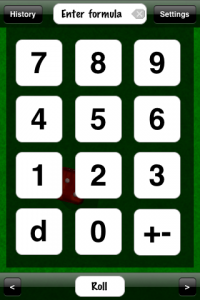
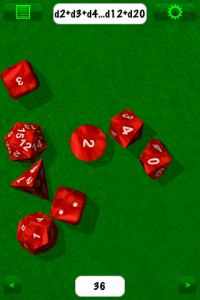
Perhaps the key difference between Pip and Mach Dice is the ability for Mach Dice to add variables into the equation. A very basic screen can be brought up allowing for d(variable) to be added or subtracted from ability scores, etc. or from other d(variable) rolls. Mach Dice offers five different tables, with differing backgrounds and arrows to scroll between. Each table can have a different set of dice on it, and a history list shows a seemingly endless set of previous rolls.
Who Mach Dice is for: The users who need a little more versatility than Pip, while being ok with a step down in graphical design. The inclusion of the variable sided die with added modifiers is a big jump from Pip. FUDGE gamers will find the required dice in Mach Dice’s options.
Who Mach Dice is not for: With added features comes added interaction. Where Pip has a simple drag and drop interface, Mach Dice requires equations to be input into the system to work properly.
Issues: Changing the color of dice is somewhat forced into the input screen. It’s an extremely distracting method to change the color of dice. Also, I’ve had instances where one of the tables come up without any graphics at all, and I can only see the top and bottom interface bars.
Recommendation: Mach Dice isn’t as crisp an experience as Pip, but still offers additional versatility without sacrificing simplicity. It’s an extremely cheap option at $0.99, and really is a great choice for the individual looking to gain an added level of customization. It’s by far the simple option for any Do-It-Yourself Gaming System (FUDGE) gamer.
Side Note: The developer recently updated Mach Dice to include the FUDGE dice, and based on his blog posting on his website, plans at least a few additional updates in the future. Support = Win!

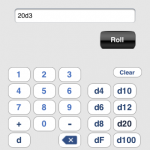
Who Quick Roll is for: Quick Roll is for the guy with multiple characters, multiple rolls, complicated character sheets, and a need to get everything under one nice umbrella app.
Who Quick Roll is not for: Quick Roll steps out of the realm of graphics and into the realm of power. It’s a lot of versatility, and if you can’t see yourself using it to its full potential, I would recommend sticking with a lighter roller.
Issues: The attack tab is good in theory, but is limited in customization making it difficult to use for people with multiple attacks w/ differing damage rolls.
Recommendation: Quick Roll provides me with everything I need, without offering me things I don’t. It’s not pretty, it doesn’t have a physics engine or a nice graphical roller, but it fits my needs. If you need power without beauty, get Quick Roll. Its slick design will keep you happy for a long time.
Side Note: Quick Roll takes a lot of up-front work, especially if you
Next month we will conclude our two part special on Dice Rollers. We will be taking a look at Multi Dice Roller, RPG Calc, and the powerhouse Dicenomicon.
Is there a dice roller that you use that's not on this list? Let us know what it is? What do you like about it? How does it compare to the above apps?
iD&D: Battlemap

Welcome, my fellow masters of geekdom, to a new monthly special running here at 148apps entitled iD&D. Each month you’ll find me, your friendly resident Dungeon Master, offering you info on some of the best (or worst) apps available in the app store that make it easier (or harder) for us to do our job. Don’t worry players; you’re not left out either. There are plenty of apps, including one that’s part of today’s article, for you as well.
Additionally I’ll be asking you, the reader, to provide us with some information each month that I will provide to the readership in the following months article. For example, this week’s question will be a survey on people who use an iDevice to enhance their pen and paper experience. Check out the end of this article for more details.
Caveat: I play the majority of my games using the Advance Dungeons and Dragons 3.5 gaming system. I’ll be referring primarily to Dungeons and Dragons (3.5), but unless otherwise stated, expect the majority of apps in this section to be universal in application. For those apps specifically for the fourth edition game system, I’ll be running smaller mini-campaigns to get a feel for their usefulness. If there may be variances from system to system, I will do my best to point them out.
Well, if I knew the 148apps lawyers, I’m sure they would be elated with me right now. As for me though, I’m anxious to get into our first article.









